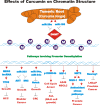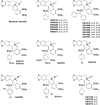Effects of resveratrol, curcumin, berberine and other nutraceuticals on aging, cancer development, cancer stem cells and microRNAs
- PMID: 28611316
- PMCID: PMC5509453
- DOI: 10.18632/aging.101250
Effects of resveratrol, curcumin, berberine and other nutraceuticals on aging, cancer development, cancer stem cells and microRNAs
Abstract
Natural products or nutraceuticals have been shown to elicit anti-aging, anti-cancer and other health-enhancing effects. A key target of the effects of natural products may be the regulation of microRNA (miR) expression which results in cell death or prevents aging, diabetes, cardiovascular and other diseases. This review will focus on a few natural products, especially on resveratrol (RES), curcumin (CUR) and berberine (BBR). RES is obtained from the skins of grapes and other fruits and berries. RES may extend human lifespan by activating the sirtuins and SIRT1 molecules. CUR is isolated from the root of turmeric (Curcuma longa). CUR is currently used in the treatment of many disorders, especially in those involving an inflammatory process. CUR and modified derivatives have been shown to have potent anti-cancer effects, especially on cancer stem cells (CSC). BBR is also isolated from various plants (e.g., Coptis chinensis) and has been used for centuries in traditional medicine to treat diseases such as adult- onset diabetes. Understanding the benefits of these and other nutraceuticals may result in approaches to improve human health.
Keywords: CSCs; SIRT; curcumin; gene methylation; miRs; natural products; resveratrol.
Conflict of interest statement
The authors declare that they have no conflicts of interest with publication of this manuscript.
Figures












Similar articles
-
Regulation of GSK-3 activity by curcumin, berberine and resveratrol: Potential effects on multiple diseases.Adv Biol Regul. 2017 Aug;65:77-88. doi: 10.1016/j.jbior.2017.05.005. Epub 2017 May 26. Adv Biol Regul. 2017. PMID: 28579298 Review.
-
Effects of berberine, curcumin, resveratrol alone and in combination with chemotherapeutic drugs and signal transduction inhibitors on cancer cells-Power of nutraceuticals.Adv Biol Regul. 2018 Jan;67:190-211. doi: 10.1016/j.jbior.2017.09.012. Epub 2017 Oct 3. Adv Biol Regul. 2018. PMID: 28988970
-
Synergistic chemopreventive effects of curcumin and berberine on human breast cancer cells through induction of apoptosis and autophagic cell death.Sci Rep. 2016 Jun 6;6:26064. doi: 10.1038/srep26064. Sci Rep. 2016. PMID: 27263652 Free PMC article.
-
Targeting cancer stem cells by nutraceuticals for cancer therapy.Semin Cancer Biol. 2022 Oct;85:234-245. doi: 10.1016/j.semcancer.2021.07.008. Epub 2021 Jul 14. Semin Cancer Biol. 2022. PMID: 34273521 Review.
-
Encapsulation of Nutraceutical Ingredients in Liposomes and Their Potential for Cancer Treatment.Nutr Cancer. 2018 Nov-Dec;70(8):1184-1198. doi: 10.1080/01635581.2018.1557212. Epub 2019 Feb 9. Nutr Cancer. 2018. PMID: 30741011 Review.
Cited by
-
SIRT1 Activation by Natural Phytochemicals: An Overview.Front Pharmacol. 2020 Aug 7;11:1225. doi: 10.3389/fphar.2020.01225. eCollection 2020. Front Pharmacol. 2020. PMID: 32848804 Free PMC article. Review.
-
Beta-Blockers and Berberine: A Possible Dual Approach to Contrast Neuroblastoma Growth and Progression.Oxid Med Cell Longev. 2020 Aug 12;2020:7534693. doi: 10.1155/2020/7534693. eCollection 2020. Oxid Med Cell Longev. 2020. PMID: 32855766 Free PMC article. Review.
-
A comparative study to evaluate the therapeutic effects of nutraceuticals in oral leukoplakia:- A randomized clinical trail.Natl J Maxillofac Surg. 2023 Sep-Dec;14(3):413-419. doi: 10.4103/njms.njms_25_23. Epub 2023 Nov 10. Natl J Maxillofac Surg. 2023. PMID: 38273920 Free PMC article.
-
Anti-SASP and anti-inflammatory activity of resveratrol, curcumin and β-caryophyllene association on human endothelial and monocytic cells.Biogerontology. 2021 Jun;22(3):297-313. doi: 10.1007/s10522-021-09915-0. Epub 2021 Mar 11. Biogerontology. 2021. PMID: 33704623 Free PMC article.
-
Nutraceuticals as Potential Therapeutic Modulators in Immunometabolism.Nutrients. 2023 Jan 13;15(2):411. doi: 10.3390/nu15020411. Nutrients. 2023. PMID: 36678282 Free PMC article. Review.
References
Publication types
MeSH terms
LinkOut - more resources
Full Text Sources
Other Literature Sources
Medical

